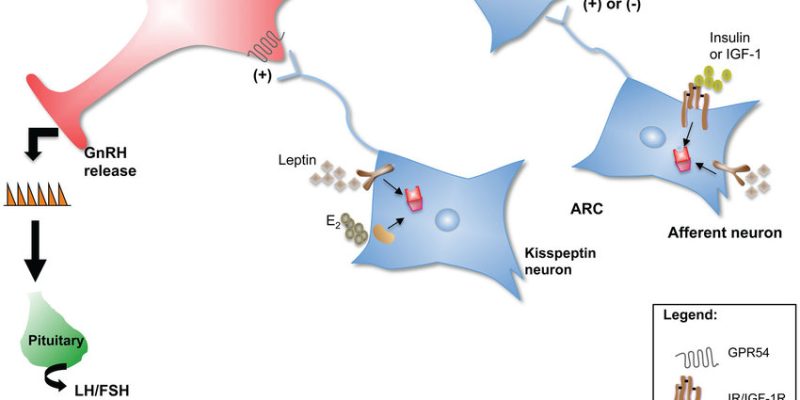Kisspeptins (Kp) belong to the protein family and are critical for fertility. In 1996, it was discovered by a group that worked in Hershey (Pennsylvania). So, it was named after Hershey’s chocolate ‘Kisses’. Kp was initially named Metasin because of its ability to inhibit cancer cell spread (Metastasis).
Current data described that besides controlling reproductive functions, kisspeptin even controls metabolism. The research was focused on the Kp neurons cluster localized in the ARC (Arculate nucleus) of the hypothalamus. It is the brain area, where metabolism and reproductive cross-talk (signals clash) occurs.
Within the hypothalamus, kisspeptin interacts with other neuropeptides including –
- Neurokinin B
- Proopiomelanocortin
- Dynorphin A
- Agouti-related peptide
- Neuropeptide Y
- The cocaine & amphetamine-regulated transcript
Besides the brain, kisspeptin is found in peripheral tissues responsible for metabolic functions. There is a lot of research associated with determining the link between reproductive functions and metabolic cues. Currently, you can buy kisspeptin at affordable rates and premium quality for treating GnRH deficiency, metastatic cancer, subfertility, etc.
Research and clinical trial reviews
Kisspeptin plays a crucial role in reproduction. When Kp cannot function properly on target cells, it causes infertility. Kisspeptin injections given to infertile women and those with amenorrhea (menstruation issue) to improve their hormone levels were effective. A single injection triggered ovulation and the eggs were fertilized artificially and inserted into the womb resulting in a successful pregnancy. Kp is involved in in-utero sexual development as well as determines the onset of puberty.
It was found that during pregnancy Kp levels escalate 7,000X in the blood as it is also present in the cardiovascular system and placenta. A few studies report that pregnant women with insufficient Kp levels in the early stage can develop serious complications later like pre-eclampsia or miscarriage. However, there is still more study necessary to focus on using Kp as a screening tool to identify pregnancy complications in the early stage, which can guide to enhanced care.
Clinical trials even suggest the link between the reproductive system and energy homeostasis or metabolism. Kisspeptin regulates the function of the HPG axis by reducing the release of Gonadotrophin.
Scientific evidence indicates that Kp is also associated with metabolism because it is also present in the peripheral tissue that controls energy homeostasis. Due to metabolic imbalance like obesity, diabetes, and malnutrition a change in the Kp neurons within these peripheral tissues was detected. In vitro experiments, Kp action on the lipid metabolism was indicated.
An animal study associated with Kp function in metabolism involved female mice with great BW (body weight), increased adiposity, hyperinsulinemia, impaired glucose tolerance, and increased fasting blood glucose. The obesity was not because of hyperphagia but reduced metabolism. The females had dramatically reduced energy expenditure. On the other hand, males had normal glucose tolerance and body weight.
In this experimental model, the study was focused on insulin resistance. The relevance to review this study is to observe the DM2 insulin resistance state because DM2 is connected with obesity and is responsible for 90% of diabetes cases.
Hyperinsulinemia, adiposity, and reduced metabolism are seen at a young age in females can accentuate the emergence of obesity as she grows adult. With compromised glucose tolerance, a decrease in metabolism, reduced energy expenditure, and developing feeding habits significantly increase the body weight as she turns into an adult.
The obese phenotype can arise from the brain and/or peripherally defective signaling. The data associated with the POMC, NPY, ghrelin receptor, melanocortin receptor 3 & 4 genes, and leptin receptor responsible for regulating the appetite system of the hypothalamus showed no changes in the participant female mice. The study suggests obesity can be due to peripheral impairment. However, there is a need for an extensive human study to identify the underlying mechanism of Kisspeptin because Kp has the potential to lessen the risk of overweight and malnutrition.
Kisspeptin injections show promising results in treating reproductive issues. Research also revealed Kp’s potential in reducing the risk of malnutrition and obesity.













Comments